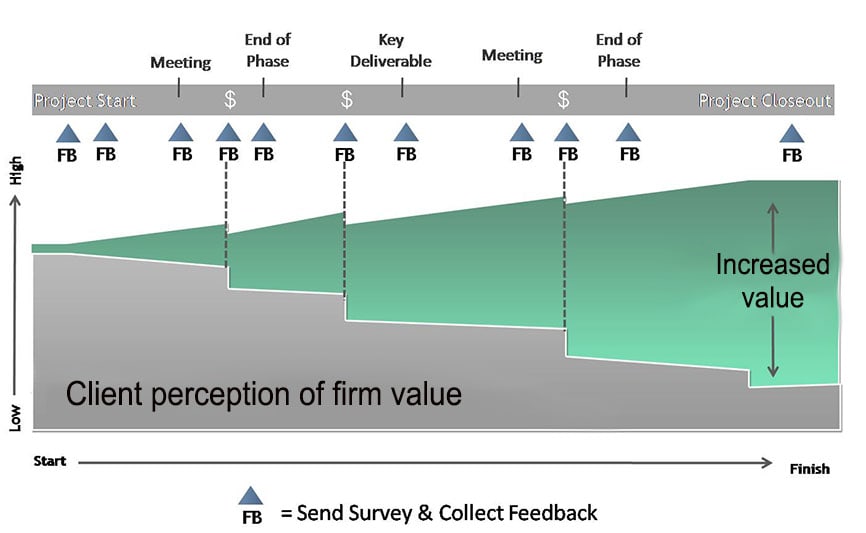What is the emotion you want your clients to feel when they think about working with you?
This is the question I asked several clients recently. It’s one of those questions I thought I knew the answer to but also realized I would be looking at the answer through my lens. I needed to hear from our clients on this one.
Here are a few responses that capture the overall theme.
Happy – that it is a good experience and confident that they made the right decision. – CEO Construction Firm
Confident – that work will get done, they'll get what they need, and they won't have to worry about it any step of the way. – CX Strategist
Joy – because we make things they find uncomfortable and difficult - fun and easier. – Legal Marketing
What do all these sentiments have in common? Trust.
Ever since the day we grasped the concept of “cross my heart and hope to die,” there is a forever realization that anxiety can only be reduced through proof of trust while waiting for a promise to be kept. From “Pinkie swear” to “I do,” we want to feel confident that promises will be kept.
Trust is the emotion that moves your clients to the other side of the gap between their expectation and their experience. It is like a bridge. Without it, the journey to the other side is unnecessarily difficult. Building the bridge takes time and effort. However, once in place, the journey forward is forever easier (unless you burn the bridge down!).
Here are three strategies that will demonstrate to clients your commitment to continuing to build trust in your relationship.
Create a Client Journey Map
One of the best ways to get to know your clients and earn their trust in your firm and your team, is through understanding your own processes and how they may affect the journey your clients travel with your firm throughout any project. Taking your team through a Client Journey Mapping exercise lets them walk through every moment your client interacts with your firm (invoicing, project kick off, deliverables, onsite meetings, problem resolutions, etc.) and take stock of their overall experience. Besides the actual moment of contact, you also get to look at the behind the scene processes; those moments leading up to each client contact. For example – as they were waiting for a project deliverable or while preparing for an important meeting. As you look at each opportunity, you gain a better understanding of what your clients are thinking and feeling at each turn of their journey with you.
As your team builds your Client Journey Map, you will likely identify friction points (from the clients’ perspective) that occur throughout the project. During the conversations that take place, your whole team can decide on a consistent way to handle these types of issues or concerns. Visualizing these encounters and discussing them as a group allows everyone to weigh options and thoughtfully decide on solutions – without the pressure of delivering on the spot. This not only ensures that, no matter what, every client has a great experience – it also gives added confidence to your staff because they now have an answer and a process to follow - whatever comes their way.
Don’t Assume. Ask?
Trust in relationships is built upon a foundation of open and fearless communication. Clients have needs. I began this discussion by ASKING others what they thought because I didn’t want to assume I knew what my clients would say. The same is true for you. The more you give your clients the chance to communicate their needs to you, the better able you are to serve them and create value.

Asking your client for feedback can be done in many ways, and it is typically a good idea to use more than one method. Our clients use the customer feedback tool, an email-based feedback system that gives clients a comfortable way of telling you what they need to say during project delivery. I highlight the timing because it is critical to building trust. By asking your clients for their feedback during the project, you give your team the opportunity to adjust before the project is complete. Think about it: if you only ask about your clients’ preferences at the end of the project, what’s in it for them? You’ve already done what you are going to do. Whether or not they’re happy about it might affect the next project, should they choose to give you the chance, but it won’t change anything that’s already happened. As seen in the figure, typical client perception of the firm's value often decreases over time (as the problem the client hired you to solve is becoming resolved). Asking for feedback both allows your team to make adjustment AND reminds the client of the value you are bringing to the relationship.
In the 14 years we have been working with clients, the majority (better than 80%) of feedback is positive. Most clients will tell your team that you are on the right track and everything is going smoothly. When a client does provide a complaint, however, be it a low score or a challenging comment, it is important for your team to view this as an amazing gift. The client has set the foundation for the trust bridge on their side of the chasm. They have told you what they need. Now you can reach across, let them know you’ve heard them, and build a permanent connection to the other side.
By simply following-up with that client complaint in a way that is professional, direct, humble, and empathetic, you build TRUST that you can handle it! Your client took a risk being open, your being receptive rewards that risk. With the trust bridge now in place, this process can be iterated. For each need put forward that is met with interest, curiosity, empathy, and compassion, you add additional supports to the bridge. And, the deeper the trust relationship, the more likely this client is to come back to you and your team for repeat work, because working with you makes them feel safe.
Develop Deep Client Relationships
“One of our Rain Makers is retiring next year, and we just know that we will lose a large chunk of our work because of it.”- Principle at mid-sized architectural firm
A major concern for most firms is that if a key staff member leaves, the work they’ve managed goes with them. After all, it is not the building, the drawings, or the assurance documents you submit, but the experience that is your firm’s product. Those team members who go above and beyond to build these relationships with clients are incredibly valuable. However, without a proactive approach to building trust in your business firmwide, any clients accustomed to working with these key staff members are at risk of leaving.
An effective strategy to neutralize this risk is to develop deep client relationships within your organizations. Let your strategy capitalize on the communication and relationship skills of your key staff, but also continually give others on the team the chance to practice and nurture their communication skills and build their own bridge of trust with the client.
How can you do this? Use your Voice of the Customer or feedback program to gather and analyze the information you are receiving from your clients on an ongoing basis. Share this information with all members of the team working with that client to ensure they are also delivering on the clients’ preferences. Next, create opportunities for the members of your team to collaborate with your clients. Have the client’s key contact make those introductions so clients will feel at ease establishing relationships (and trust) with other members of your firm. From the clients’ perspective, they now have additional points of contact, useful in case their key contact is unavailable. Not only that, but consistent positive experiences with multiple staff members gives your client the assurance that their first stellar contact was not a fluke, but a result of your company’s intentional emphasis on client experience.
“Trust me.” says every nefarious film villain ever. We naturally become suspicious of someone who needs to convince us of their trustworthiness. These three strategies will allow you to engender trusting client relationships without you ever having to utter the words.
Register for a complimentary webinar on B2B Customer Journey Mapping to learn more about how you can use this tool to build your own trust bridges with your clients.





